Garam Masala Recipe
This post may contain affiliate links. See my disclosure policy.
Garam Masala is a wonderfully versatile Indian seasoning blend that will bring an incredible depth of flavor to a large variety of dishes. The different spices play their own unique part in delivering a phenomenal symphony of flavors. Try this authentic garam masala recipe and you’ll never use store-bought again!
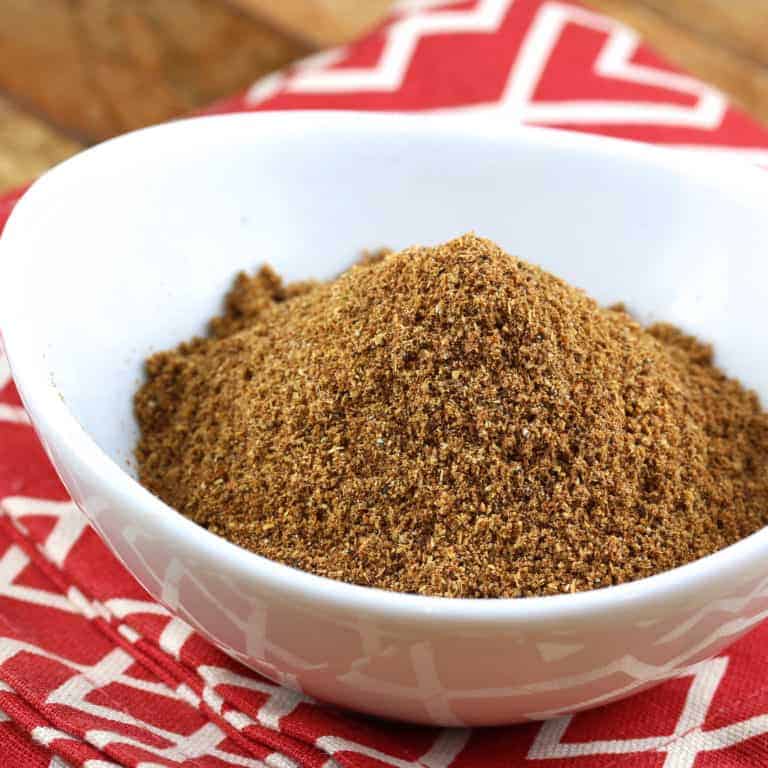
What is Garam Masala?
Garam Masala is a blend of ground spices that is popular in Indian cuisine. From Hindi for “hot” or “heat” (garam) and “mixed spices” (masala), the term “heat” doesn’t mean spicy hot but rather refers to the Ayurvedic concept of warming spices that are meant elevate the body’s temperature and increase metabolism. Per Ayurvedic tradition food should not only taste delicious but also deliver health benefits.
Garam masala blends are wide and varied depending on which region of India you’re in. And families and individual all have their own way of making it. Our garam masala recipe incorporates the spices you will find in many traditional blends.
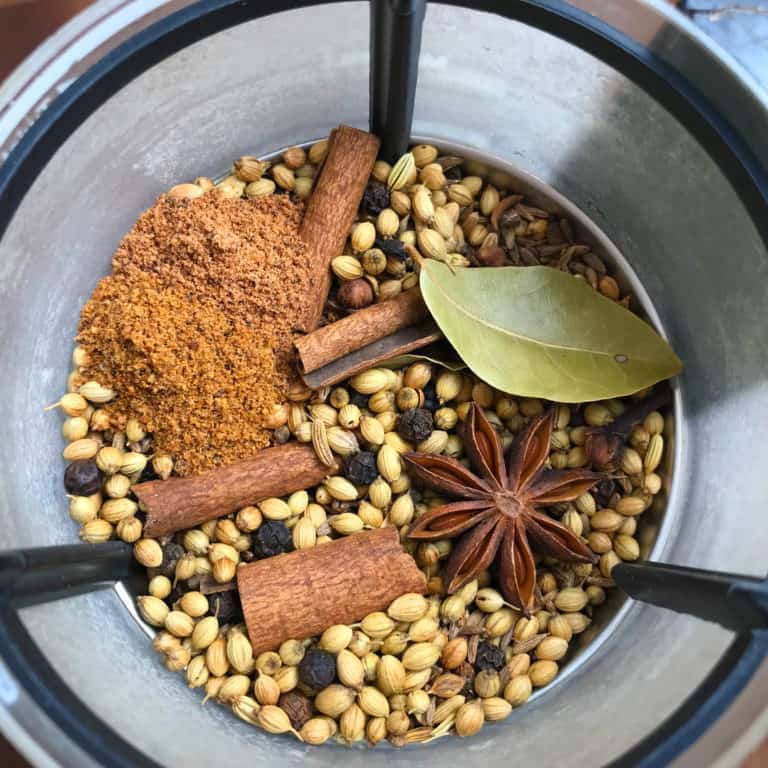
Garam Masala Ingredients
Again, recipes vary greatly but it will typically include a majority, most, or all of the following spices: Coriander, cumin, peppercorns, green cardamom, black cardamom, fennel, cinnamon, cloves, nutmeg (sometimes mace), curry leaves and star anise. This blend is believed to have originated in North India where the blends focus on aromatic and “sweet” spices. As you move further south on the sub-continent red chilies are also occasionally added for some heat.
The different spices play their own unique part in delivering a magical symphony of flavors: Cloves and cinnamon add sweetness, coriander exudes a lemony flavor, cumin adds an earthy, nutty and slightly bitter undertone, peppercorns contribute heat, cardamom adds a hint of spicy mint, nutmeg adds a wonderful complexity, and so on. Each spice possesses its own unique flavor characteristics, both complementing and contrasting each other to create a well-rounded seasoning blend that’s full of flavor and will contribute incredible depth to your Indian dishes.
Substitutions
Absolutely. There is no “one” garam masala recipe and you can alter it according to your particular tastes as well as the availability of the spices. Feel free to use our blend as a guideline for typical spices used in garam masala and tweak it according to your own preferences, both the spices themselves and the ratios.
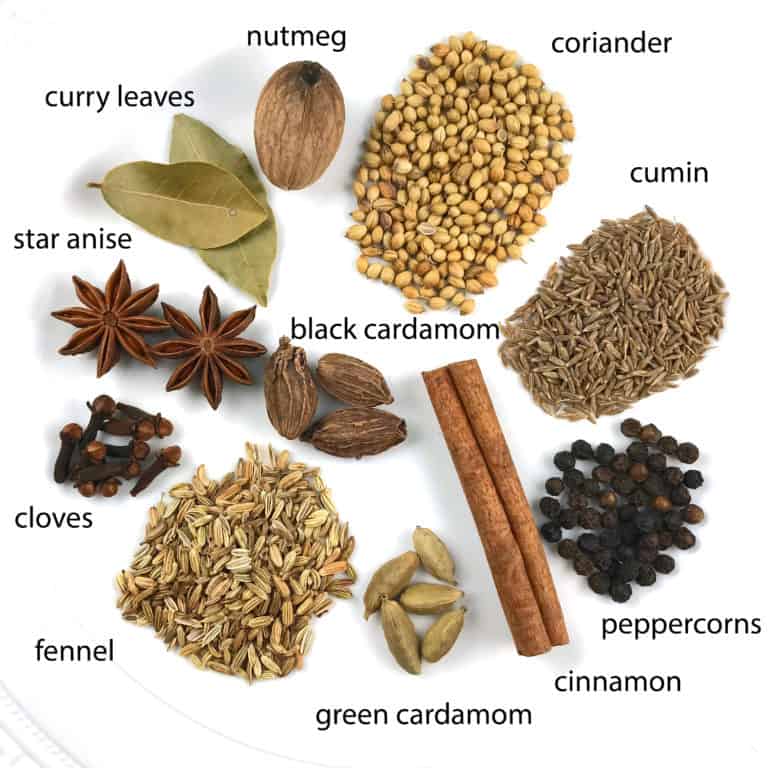
Garam Masala vs Curry Powder
This one might catch you by surprise but the first answer is garam masala is an authentic Indian spice blend used throughout the sub-continent whereas curry powder is a western invention. You won’t find any traditional Indian cookbooks that call for “curry powder.” Instead they will call for individual spices and garam masala.
But origin differences aside, there are other distinct differences between the two spice blends. Curry powder is heavily turmeric-based, gives dishes an orange color as a result, and is often much spicier. In contrast garam masala uses no turmeric and is sweeter in flavor, relying more heavily on cinnamon, cloves, star anise, nutmeg and/or mace.
Whereas garam masala is meant to be used more as a “finishing spice” added towards or at the end, curry powder is added at or near the beginning as part of the cooking process. The two have significantly different flavor profiles, serve different purposes and are not meant to be used interchangeably, though many dishes of western tradition will call for both of them.
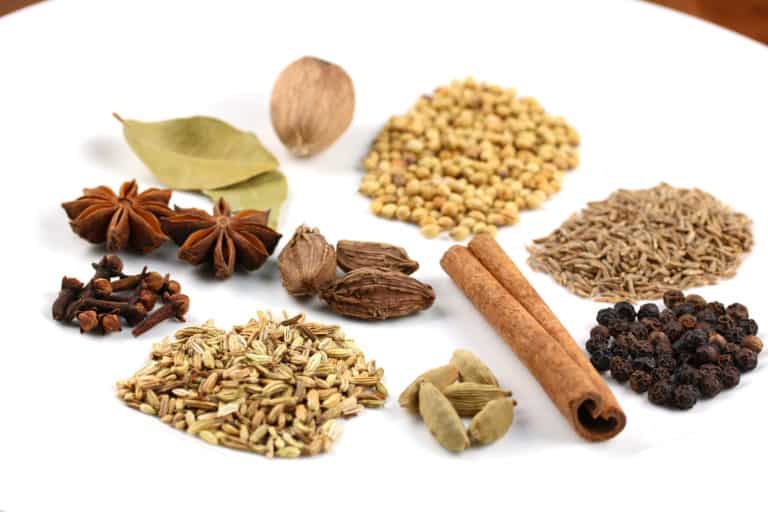
Garam Masala Recipe
Let’s get started!
Place the whole spices (reserving the ground nutmeg and mace) in a dry skillet and toast them over medium-high heat for several minutes, stirring frequently, until the spices are very fragrant and the lighter spices have become deeper golden in color.
Be careful not to scorch the spices or they will become very bitter. Transfer the toasted spices to a bowl and let them cool completely.
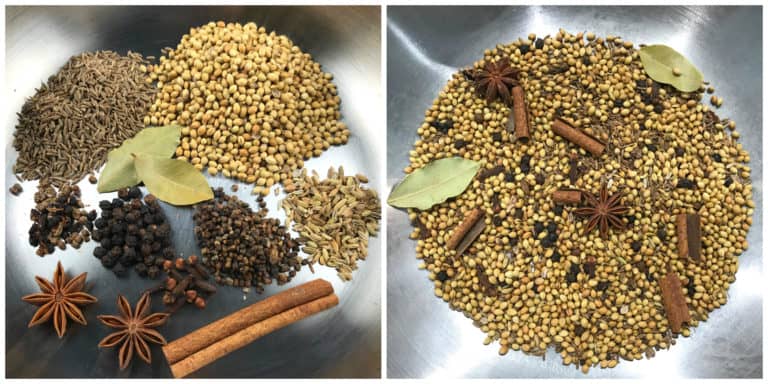
Place the cooled spices in a coffee/ spice grinder or a blender along with the nutmeg and mace. If you haven’t already done so it is easiest to grind the cinnamon if you break it into pieces.
Grind the spices until you get a fine powder. Transfer the garam masala to an airtight jar and store in a dark place. Will keep for several months but for optimal flavor use them within a month or two.
This makes roughly 1/2 cup of garam masala.
Enjoy!
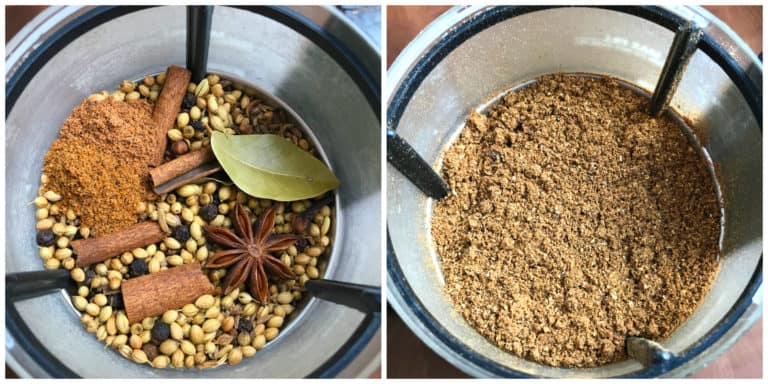
How Long Does Garam Masala Keep?
The natural oils in the freshly ground spices lose their potency quickly so this blend is best made in small batches as you need them. While it will technically last for many months its flavor weakens over time. For best results keep the spice blend stored in an airtight jar in a dark place and use it up within a few weeks.
How to Use Garam Masala
Garam masala is a very versatile Indian seasoning blend and you’ll find it called for in both meat and vegetarian dishes. In my opinion India makes some of the best vegetarian dishes because the fragrant and flavorful spices bring even the simplest of foods to life.
It is used both for its flavor and its aroma characteristics and as such is often added towards the end of the cooking process (sometimes a little is also sprinkled on top). It’s sometimes used on its own but is more often combined with additional individual spices. As with most seasonings, making it fresh from toasted ground spices and using it within a few days will give you the best possible flavor. Here are just a few things you can add it to:
- Meats, poultry and seafood
- Legumes, lentils and grains
- Vegetables
- Dry rub for grilling
- Soups and stews
- Curries
- Marinades, sauces and salad dressings
- Scrambled eggs
- Paneer and yogurt dips
- Spiced nuts
- Add some to the dough of homemade bread
- Add a pinch to cakes and cookies for a fragrant flavor twist
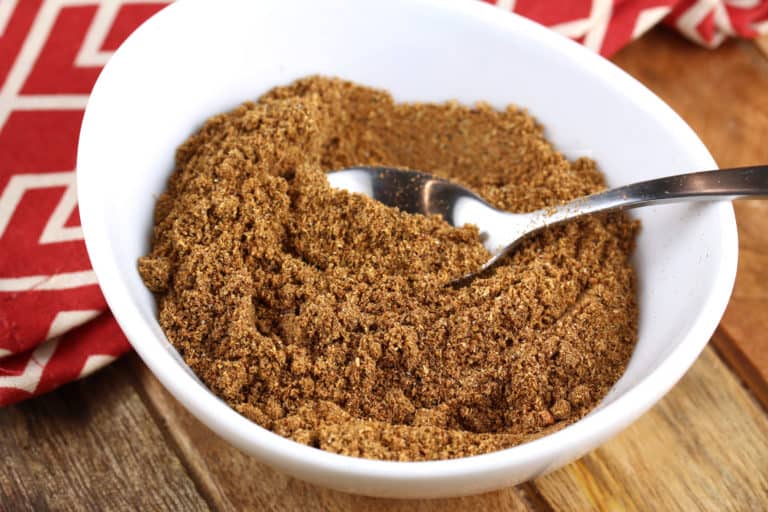
For more seasoning blends from around the world try my:
- Greek Seasoning
- Old Bay Seasoning
- Curry Powder
- Chaat Masala
- Dukkah
- Creole Seasoning
- Sazon Seasoning
- Montreal Steak Seasoning
- Shichimi Togarashi
- Everything Bagel Seasoning
- Za’atar
- Chinese Five Spice
- Chili Powder
- Mixed Spice
- Taco Seasoning
- Berbere
- Baharat
Save This Recipe
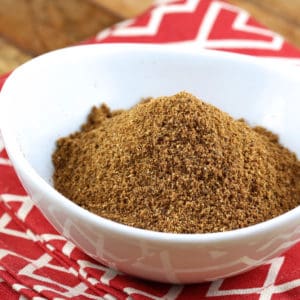
Garam Masala
Equipment
Ingredients
- 4 tablespoons coriander seeds
- 4 teaspoons cumin seeds
- 1 teaspoon fennel seeds
- 1 teaspoon black peppercorns
- 1 teaspoon green cardamom seeds
- 1/2 teaspoon black cardamom seeds
- 1 stick cinnamon , about 3 inches
- 2 star anise
- 8 whole cloves
- 1/2 teaspoon freshly ground nutmeg
- 1/4 teaspoon ground mace (optional)
- 2 dried curry leaves (can substitute one large bay leaf)
Instructions
- Place the whole spices (reserving the ground nutmeg and mace) in a dry skillet and toast them over medium-high heat for several minutes, stirring frequently, until the spices are very fragrant and the lighter spices have become deeper golden in color. Note: Be careful not to scorch the spices or they will become very bitter.Transfer the toasted spices to a bowl and let them cool completely.Place the cooled spices in a coffee/spice grinder or a blender along with the ground nutmeg and mace. If you haven't already done so it is easiest to grind the cinnamon if you break it into pieces.Grind the spices until you get a fine powder. Transfer the garam masala to an airtight jar and store in a dark place. Will keep for several months but for optimal flavor use them within a month or two. This makes roughly 1/2 cup of garam masala.
Nutrition
Originally published on The Daring Gourmet December 20, 2019



















Made it, LOVED it! Didn’t add black cardamon, only cos I don’t like it. The fragrance when you are blending, toasting and grinding is inspirational. Thank you :)
Thank you for the feedback, Christine, I’m so glad you enjoyed it!
Thank you for sharing your recipes. In those that call for green and/or black cardamom “seeds”, all the photographs show the cardamom “pods” that enclose and hide the little seeds within (as cardamom is typically sold with the seeds still inside the pod). Am I correct in assuming that the pods should be broken open and the seeds removed (and the empty tasteless pods discarded), before measuring, toasting, and grinding? Thank you for clarifying this.
Hi Jerry, you are correct, when a recipe calls for cardamom seeds it is referring to the seeds inside, not the cardamom pods. Since you mention the photos, you’ll note that the photos where the spices are actually being toasted and then ground there are no cardamom pods in those pictures, only the seeds.
What can be used to replace the black cardamom
Hi Tooyin, there really is not substitute for its unique flavor profile but you can simply omit it and the garam masala will still taste amazing! :)
Love this recipe, thank you for sharing
Hi! I am using pre-ground coriander and cumin. Should I still use 4 tsps of each, or slightly less? Thanks!
Hi Maren, the conversion of whole spices to ground depends on the particular spice, but for coriander and cumin 1 teaspoon of whole spices equals about 1 1/2 teaspoons ground.
Thank you!! I like this recipe & look forward to using it
Made this this afternoon ready to make your chicken tikka masala recipe during the week. I used my Krups coffee grinder (says Krups 75 on the side). It’s 20 years old this year!
The Garam masala smells wonderful. Thank you.
Thank you, Angela, I hope you enjoy it – happy cooking! :)
Can we freeze the Garam masala?
Hi Mary, unless you vacuum seal them, it’s not recommended to store spice blends in the freezer because it traps in humidity which spoils the spices.
veri nice aartical
Can’t wait to finally make it & use it in my cooking
Simply curious. Once the seeds are toasted they lose shelf life. So why not combine them and wait to toast them when you need them?
Hi Tina, simply for convenience. This makes a relatively small batch of garam masala. I like to keep a little on hand so I can grab and use it when I need it without having to grind up a new batch every time. This batch is small enough to where anyone who cooks Indian on a semi-regular basis will have is used up well within the time frame of optimal freshness.
You Said very nice in our Indian village people are made and also we did the Masala Red Chili Powder 3 to 6 months this masala mix in Red chili powder…
It is a very flavored site I am also coming to this site regularly in their lots of masala so it is amazing to read and also made the masala in home…
Amazing article. Thanks for sharing the recipe of garam masala. It was really helpful and informative. Finally able to make own garam masala.
Looks great and I will make it, however, to replicate something that is supposed to be “authentic” I would expect precise quantities to be listed for the ingredients.
For example you list “1 stick cinnamon , about 3 inches” — so how long is “about” AND how wide is the cinnamon? I have seen cinnamon from 1/4″ wide to 1″wide. That makes a substantial difference.
Also, you list “2 dried curry leaves” — so how big? And, if “large bay leaf”, how large?
It would be best to list ingredients by weight to always be precise — by using a gram scale.
“Äuthentic” means “Precise”? Have you ever watched an authentic grandma, or chef for that matter, cook? Authentic does not mean it is exactly the same every time!
I’m glad you had sense enough to realize that. Of course, sometimes Grandma screws up. (Mine did it with a sauerkraut that was too salty to eat. I’ll never forget that one. 🤢)